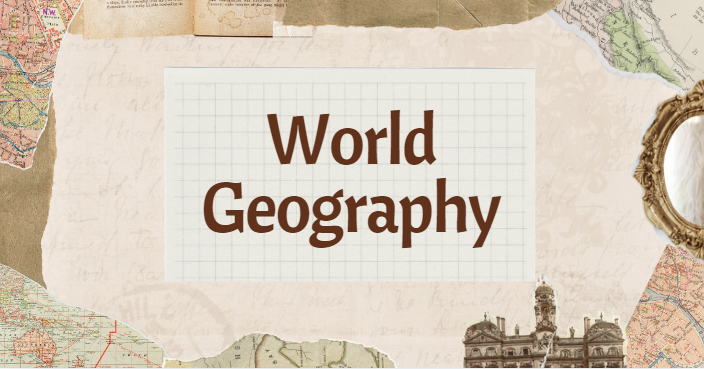Exploring World Geography: A Comprehensive Overview
World geography is a fascinating field that delves into the Earth’s landscapes, environments, and the relationships between people and their environments. This article aims to provide a basic overview of world geography, covering key concepts, physical features, human geography, and the significance of geography in today’s world.
What is Geography?
Physical geography focuses on natural features and processes, while human World Geography examines the impact of human activities on the Earth.
Physical Geography
Physical geography explores the natural elements of the Earth, including landforms, climate, ecosystems, and bodies of water. Understanding these components helps us appreciate the diversity of the planet.
Landforms
Landforms are natural features of the Earth’s surface. They include mountains, valleys, plateaus, plains, and deserts. The world’s highest landform, Mount Everest, rises to 8,848 meters (29,029 feet) above sea level, while the expansive Great Plains in North America are known for their flat landscapes.
- Mountains: Formed by tectonic forces, mountains are often found in ranges. The Himalayas, Andes, and Rockies are significant mountain ranges that shape the World Geography of their regions.
- Rivers and Lakes: Rivers like the Nile and Amazon are vital for ecosystems and human civilization. Lakes, such as the Great Lakes in North America, serve as freshwater resources and recreational areas.
Also Read : VyvyManga
Climate and Weather
Climate refers to long-term weather patterns in a specific area, influenced by factors like latitude, altitude, and proximity to bodies of water. Understanding climate zones—tropical, temperate, polar, and arid—helps explain the diversity of life and human activity around the world.
- Tropical Climate: Characterized by warm temperatures and high humidity, tropical regions support lush rainforests, such as the Amazon.
- Desert Climate: Deserts like the Sahara are defined by low rainfall and extreme temperature variations.
Ecosystems and Biodiversity
Ecosystems comprise living organisms and their physical environment. The Earth’s biodiversity is essential for ecological balance and human survival. Major ecosystems include forests, grasslands, deserts, and aquatic environments.
- Forests: Tropical rainforests are among the most biodiverse regions, home to millions of species.
- Marine Ecosystems: Oceans cover over 70% of the Earth’s surface and are vital for global climate regulation and food supply.
Human Geography
Human geography examines how humans interact with the environment and the spatial aspects of human existence. It includes topics like culture, economy, urban development, and political geography.
Population and Migration
The global population has surpassed 7.9 billion, leading to challenges in resource management, urbanization, and migration. Understanding population distribution, density, and demographic trends is crucial for planning and development.
- Urbanization: The movement of people from rural to urban areas has transformed cities into economic and cultural hubs.
- Migration: Factors such as conflict, economic opportunity, and climate change drive migration patterns, impacting societies and economies.
Cultural Geography
Cultural geography studies how culture varies across regions and how it shapes human behavior. It includes language, religion, customs, and traditions.
- Language: The world is home to over 7,000 languages, reflecting diverse cultures. Major language families include Indo-European, Sino-Tibetan, and Afro-Asiatic.
- Religion: Major world religions, including Christianity, Islam, Hinduism, and Buddhism, influence cultural practices, social structures, and political systems.
Economic World Geography
It examines how geography affects trade, industry, and agriculture.
- Resources: Natural resources like oil, minerals, and fertile land play a crucial role in economic development.
- Globalization: Advances in technology and transportation have interconnected economies, leading to a global marketplace.
The Importance of World Geography
Understanding geography is essential for various reasons, including environmental awareness, cultural appreciation, and informed decision-making.
Environmental Awareness
Geography helps us understand the environment and the impact of human activities on the planet. Issues like climate change, deforestation, and pollution are geographic in nature, requiring collective action for solutions.
Cultural Appreciation
Geography fosters a greater appreciation for cultural diversity. By studying different regions and their customs, we can promote tolerance and understanding in an increasingly globalized world.
Informed Decision-Making
Geographic knowledge is vital for policymakers, businesses, and individuals. Understanding spatial relationships helps in urban planning, resource management, and disaster response.
Conclusion
From the towering peaks of the Himalayas to the bustling streets of urban centers, World Geography shapes our world in profound ways. By exploring and understanding geography, we gain valuable insights into our environment, cultures, and the challenges facing humanity today. As we navigate an increasingly complex world, World Geography knowledge becomes ever more critical in fostering sustainable development and global cooperation.


